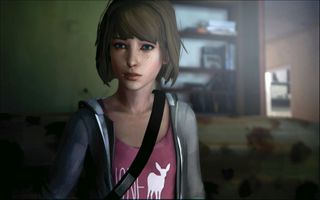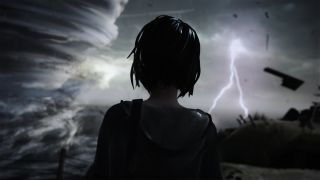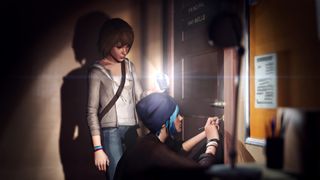Time Extend: Life is Strange
The time-bending teen drama that’s a self-aware meditation on fate


The authority on videogame art, design and play, Edge is the must-have companion for game industry professionals, aspiring game-makers and super-committed hobbyists. You can subscribe to both the print or digital editions here. Edge 323, a 25th anniversary issue with four special covers, is available now.
Welcome to the latest guest article from Edge on PC Gamer, where we occasionally feature PC gaming-related articles from the long-running magazine's recent history. This was originally published in Edge 312 in October 2017, and is republished here with the Edge team's permission.
The opening credits of Life Is Strange see Max Caulfield put in her earbuds as she walks Blackwell Academy’s corridors. She is soundtracking her life (we’ve all done it at some point), the star of her own show. And the thing about being a teenager is that you’re absolutely, devastatingly certain that the entire universe really does revolve around you. It’s not a selfish thought – not even a conscious one. You’re convinced that everything you say or do carries enormous cosmic weight. Make a mistake, and it’s the end of the world. In Max’s case, that melodramatic statement has a particular ring of truth to it.
Dontnod’s affecting tale tapped into that self-consciousness and wove it into a videogame mechanic. While the studio had played with the idea of time travel and manipulation before, in its debut game Remember Me, it found the perfect setting in Life Is Strange. After a scuffle with a bully in a bathroom leaves her former best friend Chloe Price bleeding out on the tiles, the traumatic event triggers a change in Max: she finds herself suddenly able to rewind time. Preventing Chloe’s death is, obviously, her first act, and a heroic one. Over the course of five episodes, this new ability and its applications mean Max’s story builds from teen drama to apocalyptic horror. But Max’s power also, wonderfully, becomes a much more quotidian part of her life. Regret and perfectionism are both distinctly teenage and videogamey concepts. Imagine, as an 18-year-old, you were suddenly given the power to redo almost anything at will – every embarrassing situation, every awkward conversation. Of course you would take the opportunity to min-max adolescence.
For Max, it’s about reducing her percentage chance of total social mortification: if she is mocked by a bully, it’s easy enough to hit rewind and steer the conversation in a less humiliating direction. For us, it is at least partly about the promise of a ‘good’ ending, the implication now packaged in with every game involving branching narrative and dialogue choices. Make an effort to cheer up Max’s struggling friend, selecting, rewinding and re-selecting options until satisfied with your level of control over the situation, and the secret expectation is that you will be rewarded for your philanthropy somewhere down the line. A situation in the very first episode calls more pointed attention to the fuzzy morality of Max’s fun new power. Taking a closer look at a classmate’s binned pregnancy test sees her caught red-handed by its furious owner. Respecting Dana’s privacy by not looking doesn’t get you in trouble. But you can rewind time after having already nosed your way into her affairs, meaning you’re still in the know and nobody’s any the wiser. You’re even rewarded for it later: your illicit info allows you to carefully broach the subject and Dana praises Max’s remarkable intuition, confiding in her. A regular chronokinetic Mother Theresa, our Max.

And in case the butterflies everywhere – bathrooms, Max’s journal, UI prompts reminding you that your actions will have consequences – weren’t a dead giveaway, these choices resonate. The little things web, like cracks in glass, into bigger pictures. That all-important rescue of Chloe gives rise to the main thrust of Life Is Strange: Max and Chloe’s friendship revived around the supernatural happenstance, and strengthened by their investigations into missing Arcadia Bay resident Rachel Amber. But mini-arcs set in motion develop and offer more choices and changes in the world as time goes on. Arcadia Bay and its denizens feel alive, despite iffy lip-syncing and some instances of questionable dialogue, because of the little things. Accidentally break a snowglobe in episode one, and it can still be seen, sad and smashed, in episode three. Choose to tamper with train tracks later – one of several ways to rescue the perpetually unfortunate Chloe – and a tourist you bump into in the next episode laments being stuck in town because of it. Graffitiing a wall, tampering with a guest list, signing an anti-surveillance petition: all of it affects Max’s home in subtle but visible ways, and all of it makes Arcadia Bay feel like the small town it is supposed to be. So do the moments in which you’re not really doing anything. The sleepy seaside locale is filled with opportunities to watch the world go by – to reflect upon the choices you’ve made thus far, and how they might unfold. Getting up from a convenient seat must be done with the press of a button, so flocks of swallows, Max’s inner thoughts and an atmospheric soundtrack often provide nebulous enough reasons not to, at least for a little while. Sitting on a bench outside the dormitories where squirrels play; laying on Chloe’s bed in the cold morning light to hear the full length of a song; perching on packing boxes and watching dust dance in an empty room full of memories. Few games offer this kind of contemplative downtime, and even fewer in this much style.
These are not deep internal monologues about whether Max should have had the waffles instead of the pancakes, mind you. Early on in Max’s story, a vulnerable friend of hers attempts suicide. Having frittered away much of your time-bending stamina – the limitations of which, admittedly, never really make sense – on experimental stunts, as teenagers and videogame players are wont to do, you’re unable to stop her using Max’s powers. How convincing your argument for her life is depends on how much attention you’ve been paying to her while hammering those ‘good ending’ platitudes. And there’s no fail-safe: screw it up, and she dies. Her presence is erased from the ongoing story. Candles and flowers appear at her dorm room door. It is, effectively, your fault. Many assumed the outcome was a single, preordained result until they were shown the percentage split of player decisions at the end of the episode. The fact that you’re able to prevent the worst outcome means that if it happens, it is all the more shameful.

Sometimes, Life Is Strange seems to suggest at this point, there is a right thing to say. Perhaps it is a kind of problematic fuel for the rest of the playthrough, in which your socially anxious efforts to keep everyone happy are reframed and redoubled – then thwarted by several rug-pull moments where it becomes increasingly clear that there is no correct answer, no matter how many times Max hits rewind. Exploring all the available paths of certain conversations often results in realising you must simply pick between two less-than-ideal outcomes, each with unknown and far-reaching repercussions. Meanwhile, a supposedly superhero moment in episode three prompts a heartbreaking twist that, again, holds Max and her powers accountable for her well-meaning meddling. Although the decision it leads to ultimately doesn’t matter – the timelines converge again regardless of your actions – it still feels like it means everything. In the grand scheme of things, it does. Chloe’s card is irrevocably marked, and the more you try to scrub that mark away, the more you realise Max’s superhuman efforts to save her best friend – or, according to your decisions, lover – are ripping apart Arcadia Bay. All that teen angst and timeline-tinkering has somehow manifested a very real tornado. Meanwhile, there’s only one, awful timeline in which the book on Rachel Amber’s disappearance can be meaningfully closed.
The biggest gaming news, reviews and hardware deals
Keep up to date with the most important stories and the best deals, as picked by the PC Gamer team.
Everything leads up to this choice-based, time-bending game’s knowingly contradictory message: don’t mess with fate. While it is subtler in the early episodes, episode five’s nightmare sequence hammers it home. Here, a truly ‘no win’ dialogue choice is masterfully unsettling, as is the bluntness with which Max’s doppelganger addresses her doe-eyed original and the player’s motivations in one fell swoop. “Thought you could control everybody and everything, huh?” she mocks. “I only wanted to do the right thing,” you might reply. “No, you only wanted to be popular,” retorts the other Max. “Your big plan was to trick people into thinking you give a rat’s ass.” Life Is Strange’s greatest achievement is that despite their cringeworthy memespeak and wooden facial expressions, by the story’s end, you do care about the residents of Arcadia Bay. It makes the inevitable final decision you must make, faced with a cataclysmic storm and the realisation that you may have done more harm than good, all the more difficult.
But if you’ve been paying attention, there is only one choice to be made. It is borne out by its ending – a beautifully scored, lengthy and sentimental sequence. The alternative, meanwhile, is a hurried consolation prize whose very existence seems to undermine what Life Is Strange has been trying to say for five episodes. There’s a sense that Dontnod felt pressured to provide players with the level of immersive agency to which they have grown so accustomed, despite its game making an occasionally flawed but often rather elegant meta-case against altering a narrative according to one’s wants and whims. It’s a shame, then, that it couldn’t find the strength to make its final point a mandatory one. But provided players are mature enough to bear out a wonderfully introspective arc to its logical conclusion, Life Is Strange is one of gaming’s greatest coming-of-age stories, no matter how old you are. The quintessential teenage epiphany is once again posited to the modern, Telltale-coddled player of choice-based games: perhaps the whole world doesn’t revolve around you, after all.
Most Popular

